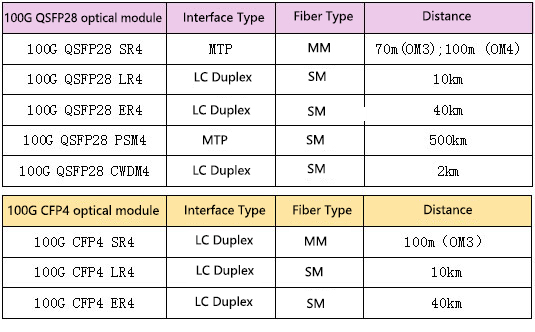

 Knowledge Base +
Knowledge Base +  2024.01.29
2024.01.29As the scale of the 100G industry expands and the development of optical communication data centers accelerates, it is an inevitable trend. The cost of 100G optical modules will correspondingly decrease, thereby reducing the overall cost of deploying 100G networks.
The 100G QSFP28 optical module first appeared in 2013. After several years of development, it has spawned multiple categories, each with different optical module standards suitable for different transmission applications.
The 100G CFP optical module, also known as the 100G client-side module, is a form-factor pluggable module that supports hot-swapping. The CFP series of optical modules have undergone development from CFP to CFP2, and now CFP4 optical modules have been successfully introduced and widely acclaimed.
In 5G, "G" stands for "Generation", and 5G refers to the fifth generation of communication. The "100G" denotes the data rate of the optical module. QSFP28 and CFP4 are the packaging representations of the optical modules, representing the unified specifications of form factor, transmission/reception range, fiber transmission channels, and related protocol provisions. So, which has the advantage in terms of performance and price between the 100G QSFP28 and 100G CFP4 optical modules?
QSFP28 Optical Module VS CFP4 Optical Module
● Port Density
The CFP4 optical module is the latest generation of 100G optical modules in the CFP packaging form. Compared to the QSFP28 optical module, even though its width is 1/4 of the size of the first generation CFP, its packaging form is still larger than the QSFP28 optical module, indicating that the QSFP28 optical module has a better port utilization rate.
● High-Density Wiring
The 100G QSFP28 optical module uses four optical fiber channels to transmit data, and the transmission rate of each optical fiber channel can reach up to 28Gbps, mainly used for 100G transmission applications. Compared with the 100G CFP4 optical module, the 100G QSFP28 optical module is more suitable for high-density wiring, and most data centers tend to choose the 100G QSFP28 optical module.
● Optical Module Classification
The 100G QSFP28 optical module and the 100G CFP4 optical module have spawned multiple categories respectively. Below, I will present the categories of the two in tabular form:

From the above table, it can be seen that firstly, the category of the 100G QSFP28 optical module is more than that of the 100G CFP4 optical module, and the party with more categories has a wider range of applications. Secondly, in terms of transmission distance, the 100G QSFP28 optical module conforms to the market development demand. Overall, the 100G QSFP28 optical module has more advantages in both price and performance compared to the 100G CFP4 optical module.
Additional Learning Hub Resources
Which Cat6, Cat6a, and Cat7 Ethernet cable is best for 10Gb?
200G QSFP56 Optical Module Overview
Cisco 400G QSFP-DD Optical Transceivers Overview
800G OSFP Optical Transceiver Module Overview
Subscribe to the newsletter
for all the latest updates.
2-5# Building, Tongfuyu Industrial Zone, Aiqun Road, Shiyan Street, Baoan District, Shenzhen. China
